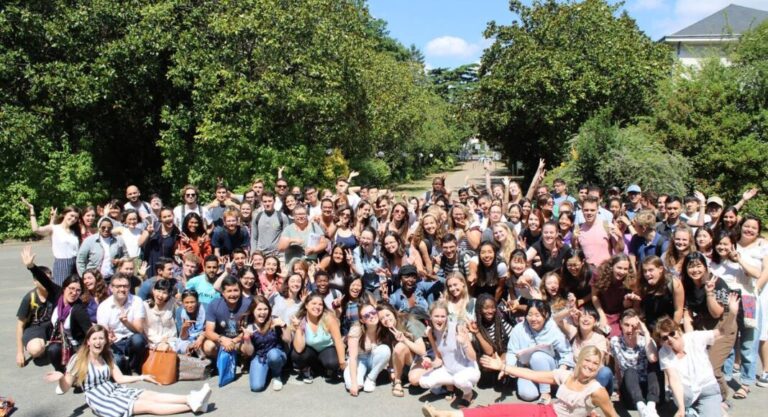If you live in the U.S., where a college education or a rogue hospital bill can land you in debt for the rest of your life, you’ve probably wondered if moving to another country could help offset your overall cost of living. France, which has excellent social benefits and is a popular destination for American expats, is one of the countries you might be considering if the idea of moving abroad has sparked your interest. So, we’ve put together a cost of living comparison between France and the U.S. While prices for housing, dining, and transportation can vary greatly according to region, as well as your individual budget and lifestyle, these are some of the major expenses you can anticipate.
Major Factors: Cost of Living in France vs. USA
Housing Costs
Rental Prices in Urban vs. Rural Areas
The average rent price in the United States is $1,372, though of course this varies widely across different states and cities. For example, as of writing, Hickory, North Carolina is the most affordable place to live in the U.S., with a median monthly rent of $743. Meanwhile, expensive destinations like New York City have a median rent of $3,500 per month. Rural states like North Dakota ($880), Iowa ($974), and West Virginia ($992) have far cheaper average rent prices, while states that are closer to major U.S. cities, like California ($1,958), New Jersey ($1,850), and Massachusetts ($1,811) have higher average rent prices.
Meanwhile, the average rent for an apartment in France is 555€ ($602) for a one-bedroom, 734€ ($796) for a two-bedroom, and 899€ ($975) for a three-bedroom. Paris, Lyon, and Bordeaux are the cities with the most expensive real estate prices in France. A one-bedroom in Paris will probably run you between 980€ ($1,063) and 1,350€ ($1,465), depending on how close to the city center you are. Another popular tourist city, Nice, has one-bedroom apartments in the 750€ ($814) to 925€ ($1,004) range. For a smaller city like Montpellier, you can expect to pay between 625€ ($678) and 740€ ($803) per month for a one-bedroom. If you’re looking for accommodation in more rural areas, however, you could pay even less. A two-bedroom apartment in Monpazier in the Dordogne region might cost you as little as 560€ ($608) per month, and a two-bedroom cottage in Aulnay in the Charente-Maritime only 520€ ($564).
So, generally speaking, rent prices in France are lower than they are in the United States, particularly when comparing rent prices in major cities.
Property Ownership Costs
In France, the average cost to purchase property per square meter is approximately 6,420€ (equivalent to $648 per square foot). Cost varies from city to city, with apartments being slightly cheaper per square meter than homes. Paris is the most expensive city to buy property in, at about 9,700€ per square meter ($979 per square foot) to buy an apartment, and 10,400€ per square meter ($1,049 per square foot) to buy a house. Lyon and Bordeaux are the next most expensive cities, but both of them clock in prices per square meter that are half that of Paris. If you’re looking to buy an apartment or house in a cheaper French city, consider Nîmes, Le Havre, or Saint-Étienne, where prices per square meter range from 1,400€ to 2,900€ ($141-292 per square foot). The most expensive regions for buying property in France are the Paris region, the Alps near Annecy, and the Côte d’Azur. You’ll find prices in more expensive cities, like Nice or Bordeaux, averaging 5,870€ per square meter ($592 per square foot), and 5,273€ ($532 per square foot), respectively. The cheapest regions can be found in central and northeastern France. In Indre, for example, the average price per square meter is 1,023€, or $103 per square foot. In Aisne, the average is 1,236€ per square meter, or $125 per square foot. Mid-range cities like Grenoble (2,853€ per square meter/$288 per square foot) and Rennes (2,783€ per square meter/$281 per square foot) offer a reasonable middle ground.
In the U.S., the average price per square foot to buy a single family home is $168, and the average cost of a new home is $511,000. The top most expensive states to buy property in, measured in square feet, are Hawaii ($681.09), California ($425.55), Massachusetts ($417.45), and New York ($416.33), with the cheapest being West Virginia ($133.72), Mississippi ($142), and Ohio ($147.73). Major U.S. cities can be far more expensive to buy property in, however, with median home prices as high as $1,381,264 in San Francisco, $869,305 in Los Angeles, and $834,096 in New York City. On the other end of the spectrum, cities like Flint, MI ($57,308); Youngstown, OH ($58,738); and Reading, PA ($94,340) have much more affordable median home prices. Ranking median price per square foot, four Californian cities came in at the most expensive: San Jose ($845), San Francisco ($705), Los Angeles ($641), and San Diego ($587); followed by New York City ($490).
In total, property costs in France are more expensive per square foot. However, the average French home is much smaller than the average U.S. home, only 1,206 square feet, compared to 2,164 square feet in America. This would mean that a standard sized house in France would cost an estimated $781,488, while a standard sized house in the U.S. would cost $363,552, about half the price. But if you’re willing to explore less expensive parts of the country, you could easily find houses or apartments for sale that are comparable with U.S. prices.
Utility Costs Comparison
You can expect to pay somewhere between 160€ and 200€ ($174-217) per month in France for utilities, including gas, water, and electricity. By comparison, Americans spend, on average, $429.33 per month for utilities. (It’s worth keeping in mind that air conditioning, which can rack up your electric bill in warmer months, is rare in France.)
While you’re setting up your utilities, you might also be curious about internet costs in France vs. the U.S. While costs vary according to your internet provider, whether you bundle your internet with your mobile phone service, and the speed of your internet, you can expect to pay around 30€ per month ($33) for internet service in France. (You can learn more about how to save on internet spending here.) In America, the average monthly cost for internet is $65.
France/United States Food and Dining
Grocery Shopping Costs
Compared to the United States, France has a local purchasing power ratio (PPP) of 0.674. The lower the PPP, the less you have to spend to get the same quality of goods and services as you would in America. Essentially, this means that your money can go a lot farther in France, as consumer prices can be much lower related to average income.
On average, the French spend 300€ on food per person ($325), per month, between dining out and eating in. The average American household, however, spends a little over $1,000 per month on groceries alone. The most expensive city to buy groceries in is Miami, at an average of $1,300 per month. California in general has higher grocery costs than the rest of the country, while also containing specific high cost locations like San Francisco and Los Angeles. The cheapest groceries can be found in the Midwest, in states like Indiana, Iowa, Michigan, and Nebraska, where average monthly groceries cost around $950.
It’s worth keeping in mind that, though grocery shopping in France is far cheaper on average than in the U.S., the quality of food is very high. Artisanal cheeses, meats, and pastries cost far less than they would in America, so you’re also getting better food for cheaper prices.
Dining Out: Fast Food to Fine Dining
Average restaurants in France will run you about 15-35€ for a three course meal ($16-38), depending on where in the country you are, and whether you’re eating out for lunch or dinner. A fast food meal at a chain like McDonald’s is likely to run you about 10€ ($11).
Americans spend an average of $166 per month eating out, with most meals costing somewhere between $11 and $30 per person. The most expensive state to eat out in is New York, and the least expensive is Wyoming. U.S. fast food prices vary by state. Looking specifically at McDonald’s, they are highest in Alaska, and lowest in Wyoming. Paying $13 for a Big Mac meal is roughly standard, but prices can go up to $18.
Let’s talk about fine dining. Several French cities made the list of the most inexpensive cities in the world to enjoy a Michelin-starred meal, including Montpellier (with an average Michelin tasting menu cost of $128), Dijon ($133), Lyon ($139), Bordeaux ($139), and Toulouse ($144). No French cities were among the most expensive cities to enjoy a Michelin-starred meal, but San Francisco ($263), New York ($258), Miami ($257), Atlanta ($245), and Los Angeles ($238) were. This doesn’t mean that there aren’t extremely expensive restaurants in France, particularly if you’re in a touristy city like Paris or Nice. But, in general, quality food in France, even from high end restaurants, is more affordable than it is in America.
Alcohol and Beverage Prices
As you would imagine, wine is quite cheap in France compared to the United States. A decent bottle of wine will cost you around 7€ ($7.60) at the grocery store, while you’d have to spend closer to $10-15 for an equivalent bottle in the U.S. In France, a glass of wine at a cafe or restaurant will cost you about 5€ ($5.40), while that same glass could cost you between $8-15 in the U.S. Beer and cocktail prices are relatively comparable between the two countries.
France/United States Healthcare Expenses
Insurance Costs
France’s healthcare system is subsidized by the state, so monthly insurance payments are quite low. The average annual health insurance cost per person is €979 ($1,062) in France, though it will cost more if you are older, and average prices vary by region. By comparison, annual health insurance premiums in the U.S. cost an average of $8,435 per person.
Out-of-Pocket Medical Expenses
Though you may have to pay a copay of 25-30€ ($27-33) to visit a doctor in France, most of this amount will be reimbursed. Average copays in the U.S. fall between $26 and $44. But when it comes to emergency medical care, the difference between countries is night and day. In France, emergency medical care, including surgeries, is 100% reimbursed if you have public insurance, though you may have to pay a nominal 18€ per night ($19.50) bed fee. In the U.S., hospital stays cost, on average, $11,700, but they can be double or triple that, depending on your insurance and the cost of any operations you may need to undergo.
France/United States Transportation Costs
Public Transport Fees
One of the great things about living in France is that most towns and cities are very walkable, and public transportation is widely available. In Paris, a monthly Navigo pass for public transit will cost 86,40€ ($93.74) . In Nice, a public transit monthly subscription costs between 22,50 € and 45€ ($24.41-48.82). In Bordeaux, it costs 51,80€ ($56.20).
By comparison, most U.S. cities do not have reliable public transit options, with the exception of certain places like New York City, Washington D.C., Philadelphia, or Chicago. A monthly subway pass will cost you $132 in NYC, $96 in Philadelphia, or $75 in Chicago.
Cost of Owning a Car
You don’t necessarily need a car when living in France, particularly if you live in a city, but if you are living in a more rural area, one might come in handy. While you can ship cars to France, it doesn’t make a lot of financial sense to do so, as this will incur the 20% VAT (Value-added tax) that France imposes on goods and services. If you are a U.S. citizen relocating for work, this tax will be decreased to 10% of your car’s value, though this could still be a substantial sum.
The average price to purchase a new car in France is approximately 29,000€ ($31,450). There will then be a fee to register your car and obtain a carte gris, which varies by region but will generally be about 300€ ($325). The cost of diesel gas is about 1.74€ per liter ($7.15 per gallon), which would come out to about 87€ ($94.39) for a full tank of gas. Annual car insurance in France can range from 153€ to over 500€ ($166-542).
The average cost to purchase a new car in the U.S., by comparison, is much higher, at around $47,000. Registration varies by state, but averages fall between $30 and $50. In the U.S., a gallon of gas averages (currently) at about $3.62, or around $38 for a full tank. The average cost of annual car insurance in the U.S. is $1,547.
What this means is that while gas prices are high in France, the costs to purchase a car and insure it are much lower, so it would take you quite some time for your gas costs to break even with the savings obtained from buying a car in France.
Ride-Sharing and Taxis
A recent study from NetCredit uncovered some interesting details about average Uber prices in major cities around the world. For a 10 km (just over 6 mile) ride, New York City has the highest average rate, of $34.74. Washington, D.C. comes in at $21.86, and Los Angeles at $18.58. But smaller U.S. cities like El Paso can be as cheap as $12.56 for the same journey. Ubers in Paris, by comparison, average at around $28.89 per 10 km journey. Though they didn’t include other major French cities, by using the same criteria, rough estimates include comparisons of 27€ for Nice, 21€ for Lyon, and 19€ in Strasbourg.
France/United States Education Cost
In the U.S., the average yearly cost for university tuition is $42,162 per year at a private university; $23,630 for public, out-of-state tuition; and $10,662 for public, in-state tuition. By comparison, undergraduate tuition costs in France are only 170€ ($184) per year. So if you are considering moving to France to get a degree, or moving your family and children there, education costs can make a massive difference in the long term.
General Cost of Living Comparison: France/United States
In conclusion, France is far more affordable than the United States, particularly where healthcare and education are concerned. Renting, utilities, and grocery costs are cheaper in France, as is buying and insuring a car. The two main areas where the U.S. wins out are gas prices and real estate, as it is more expensive to rent in the U.S., but less expensive to buy a house compared to France. But if you choose to rent, you will find an overall higher quality of life for less money, without having to worry whether you can afford to send your kids to college, or get a lifesaving surgery.

France/United States Cost of Living FAQs:
What are the general differences in cost of living between France and the USA?
The largest differences in cost of living between France and the United States concern education and healthcare, both of which are enormously expensive in the USA, and very cheap in France. However, rent, groceries, and other daily costs are also more affordable in France.
How do healthcare costs compare in France and the USA?
Healthcare is far cheaper in France than in the U.S., with average annual premiums costing 979€, compared to $8,435 in America. Hospital stays are also far cheaper, as they are largely subsidized in France, but can cost tens of thousands of dollars in America.
What is the cost of education in France compared to the USA?
Average yearly university tuition costs between $10,662 and $42,162 per year in the U.S., and only 170€ per year in France.
What are the cheapest and most expensive cities to live in France?
To find inexpensive cities in France, you should look to more rural areas like the Dordogne or Indre departments. However, inexpensive cities include places like Montpellier and Lille.
Can Americans live cheaper in France than in the USA?
The cost of living in France is lower than in the U.S., and provides an overall higher quality of life. This makes France an excellent option for Americans considering a move abroad.
Catherine Rickman is a writer, professional Francophile, and host of the Expat Horror Stories podcast. She is currently somewhere in Brooklyn with a fork in one hand and a pen in the other, and you can follow her adventures on Instagram @catrickman, or on TikTok @catinthekitchen.






